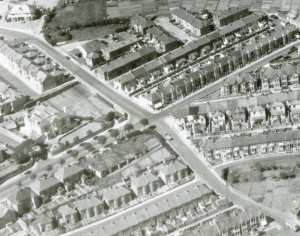|
OLD PLYMOUTH
. UK |
||
|
© Brian
Moseley, Plymouth Webpage created: April 05, 2020 Webpage updated: April 05, 2020 |
||
|
- ANGLICAN CHURCH OF SAINT MARTIN The Anglican Church of Saint Martin was planned under the Three Towns Church Extension Scheme to be erected in Tavistock Road, now Outland Road, at the junction with Weston Park Road but it was only partially completed before being abandoned. In spite of holding many fund-raising events to raise the £5,000 needed to build the Church only the Crypt was ever completed.
Only the crypt
of Saint Martin's Church was ever By 1909 the population of the parish of Pennycross had grown considerably by the erection of new houses and villas around what was then the Devonport to Tavistock road. Indeed, Plymouth's tramway system extended along Peverell Park Road to Peverell Corner and Devonport's lines reached Tor Lane. The time was ripe for a new church to save these new inhabitants from having to walk down Honicknowle Lane to the Church of Saint Pancras. The incumbent of Saint Pancras, the Reverend W E Waddington, MA., was thus given the task of raising funds for the erection of this new building, which was to bear the name of St Martin. The land was conveyed to four prominent parishioners, the Reverend Doctor Trelawny-Ross, Admiral Wilson, Mr Richard Bayly and Mr R S Tuttle. In the presence of a large congregation, the Bishop of Exeter laid the memorial stone during the afternoon of Saturday November 19th 1910. The crypt had already been completed at that time. It could hold 400 people and was expected to be used for services at Christmas. The Church was designed by Mr W W Caröe and the contractor was to be Mr A Andrews, with Mr W Martin as clerk of works. It would have accommodated about 700 worshippers. When the Reverend W Kitley became the vicar of the Church of Saint Pancras in 1917 he was eager to proceed with the building but declared that there was some doubt that the present foundations would support the superstructure. Only the the crypt was ever completed and it was used for services during the Second World War, when Saint Pancras was damaged. At that time the vicar was the Reverend Llewellyn Jones. One of the Churchwardens, Peverell Ward Councillor Norman Willie Lamb, lived opposite the site atnumber 36 Limetree Road. It was in a bad state repair, with a leaking roof and no toilet facilities, and was closed when the re-consecration of the Church of Saint Pancras took place on Saturday July 14th 1956. The Crypt remained on the site until the road widening in the 1970s, after which it was grassed over and seats placed there. There is no record of the ground ever being consecrated.
|
||
